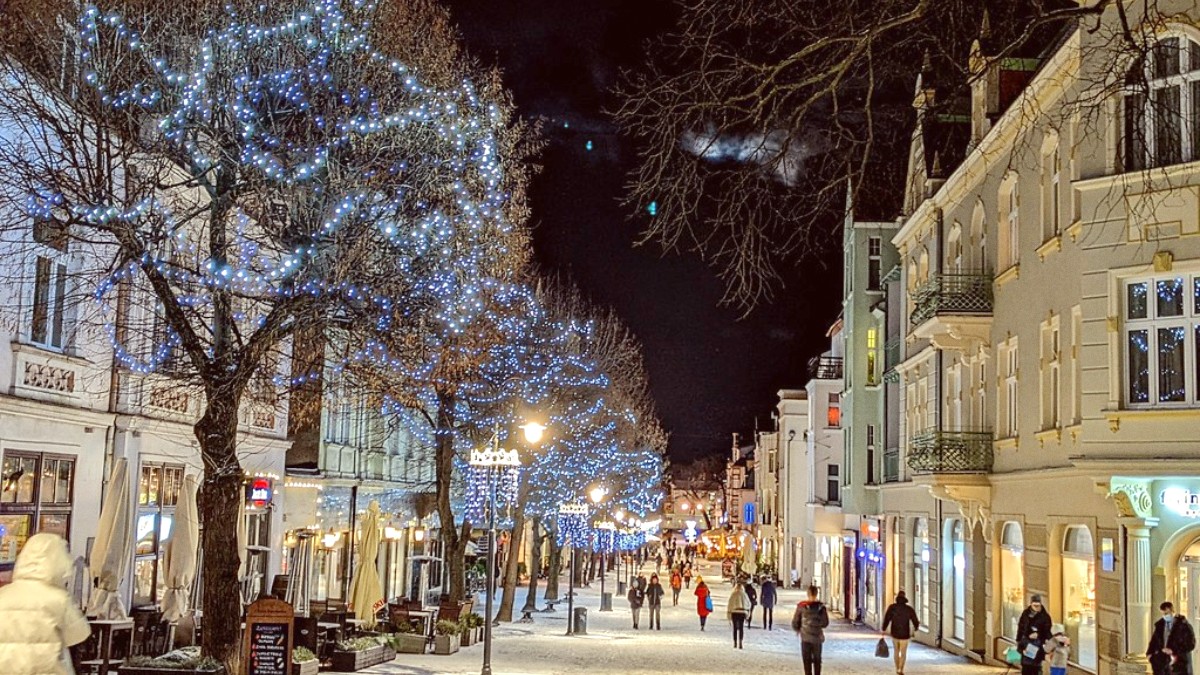
Pomerania, Poland
Polish food often presents fermented ingredients (like sauerkraut and pickled cucumbers), root vegetables, various meats (pork, chicken, beef), and grains. Historically, the cuisine was warming and filling, suited for long, cold winters.
The Baltic Sea's influence in Sopot means seafood is a more prominent role than in landlocked parts of Poland. Fisherman's fare, simple yet flavorful preparations of cod, herring, and flounder, form a regional specialty. The Tricity area saw a surge in modern culinary trends, with chefs reinterpreting traditional dishes and incorporating international flavors, creating a diverse dining scene.
Generally, European table manners apply. Keep both hands visible on the table. Wait for everyone to be served before starting to eat.
Saying "Smacznego!" (pronounced "smahtz-NEH-go," meaning "Enjoy your meal!") to fellow diners before starting a meal is polite. Others often return the greeting.
Tipping is common. A 10% tip is standard for good service in restaurants. For exceptional service, 15% is generous. For smaller bills, rounding up is acceptable. If paying by card, specify the tip amount before the transaction, or leave cash.
Polish dumplings, a true national dish. Fillings include: Ruskie (potato and cottage cheese), Z Mięsem (minced meat), Z Kapustą i Grzybami (cabbage and mushrooms), Z Owocami (fruit).
Find them in traditional Polish restaurants ("Restauracja Polska") and "pierogarnie" (specialized pierogi restaurants).
Bigos: "Hunter's Stew" with slow-cooked sauerkraut, fresh cabbage, various meats, often mushrooms and prunes. Żurek: Sour rye soup, often with white sausage and a hard-boiled egg, sometimes in a bread bowl.
Widely available in traditional Polish restaurants.
With Sopot's location, trying fresh fish from the Baltic Sea is a must. Cod (dorsz), flounder (flądra), and herring (śledź) are common, often simply fried or baked.
Found at restaurants near the pier and beachfront, or specialized fish restaurants. "Bar Przystań" in Gdańsk Jelitkowo is famous for fresh fish.
Vodka (Wódka): Poland's national drink. Beer (Piwo): Very popular, with a thriving craft beer scene. Miód Pitny (Mead): Fermented honey drink. Kompot: Non-alcoholic fruit compote. Local Mineral Water.
Pączki: Polish donuts, often with rose or plum jam. Sernik: Polish cheesecake, made with farmer's cheese. Makowiec: Poppy seed roll.
Sopot presents restaurants focused on modern Polish cuisine or international flavors, using high-quality ingredients and refined service. Many are within luxury hotels or in standalone elegant settings.
This category forms the bulk of Sopot's dining scene. They present diverse menus, including traditional Polish, Italian, Asian, and other European cuisines, with a comfortable ambiance and reasonable prices.
These establishments include traditional cafeterias or quick service spots. "Bar Mleczny" (Milk Bars) are state-subsidized cafeterias offering very affordable, home-style Polish food. No-frills, self-service.
A good selection of international cuisines are present, including Italian (pizza, pasta), Asian (sushi, Thai, Vietnamese), Middle Eastern (kebabs), and other European restaurants, especially in the central area.
Variety to suit every palate.
Sopot does not feature a large food hall. Local markets might offer fresh produce, cheeses, and some prepared foods. For a more extensive market experience, visit Hala Targowa (Market Hall) in Gdańsk.
Discover local goods.
For an authentic and inexpensive experience, seek out a "bar mleczny" or a local fish eatery away from the main tourist area.
Venture beyond Monte Cassino for dining experiences that present different atmospheres and specialties.
Engage with restaurant staff and try local phrases for a more immersive dining experience.
Given Sopot's coastal location, prioritizing fresh Baltic fish dishes is a definite recommendation.
Awareness of gluten-free (bezglutenowe) and other allergens is growing in Poland. Some restaurants will list gluten-free options on their menus.
Always communicate your specific dietary needs clearly to restaurant staff.
Having a Translation card with your dietary restrictions written in Polish can be very helpful. This promotes clarity and avoids misunderstandings.
A simple tool for clear communication.
Use apps like HappyCow to find vegetarian and vegan-friendly restaurants. Before your trip, search online for Sopot restaurants catering to specific dietary needs.
"Jestem weganinem/weganką" (I am vegan - male/female), "Jestem wegetarianinem/wegetarianką" (I am vegetarian - male/female), "Bez glutenu" (without gluten) are useful phrases.
Cooking classes focused on traditional Polish cuisine are available in nearby Gdańsk, easily accessible by SKM train. These classes involve preparing dishes like pierogi or bigos. Food tours, typically in Gdańsk, present a guided exploration of local markets, specialty shops, and traditional eateries, with historical and cultural context.
Opportunities for farm visits or tours of local food producers are more likely in the broader Pomeranian region (e.g., Kashubia) rather than directly from Sopot. These would typically ask for a car or an organized tour.
The Tricity area hosts various food festivals throughout the year, especially during warmer months. These events celebrate local produce, traditional dishes, and international cuisines. Check local event listings or tourist information for current schedules.
Participate in a cooking class to learn the art of preparing traditional Polish dishes like pierogi. This offers a hands-on culinary experience beyond just tasting.
A memorable way to connect with local food culture.
Consider a food tour in nearby Gdańsk for a guided journey through local markets and eateries. Knowledgeable guides present context to the culinary traditions.
Discover hidden gastronomic delights.
Sopot's coastal location means fresh Baltic fish is a culinary centerpiece. Seek out local establishments that specialize in simply prepared, flavorful seafood.
Beyond traditional Polish fare, Sopot offers a wide array of international cuisines, catering to diverse tastes and preferences. Explore the global culinary landscape.
Experience the comforting and savory characteristics of traditional Polish dishes, often featuring hearty ingredients and distinct seasonings.
Sopot's dining scene presents a delicious journey through Polish traditions and global tastes. From humble milk bars to upscale restaurants, every meal can contribute to a memorable experience.